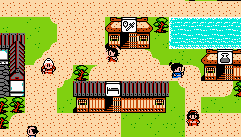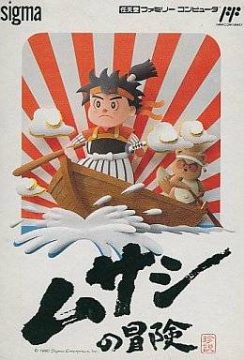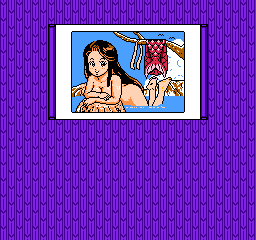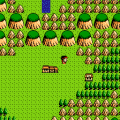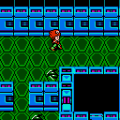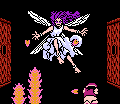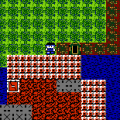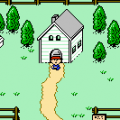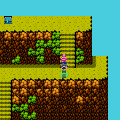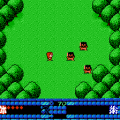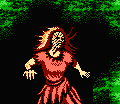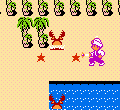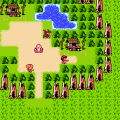Musashi no Bouken, or “The Adventures of Musashi”, is another obscure Japanese Dragon Quest clone RPG for the Famicom that was developed by Quest and published by Sigma E in 1990. While the game doesn’t really add anything new to the DQ formula, it’s still a pretty cool game with some notable content. The most obvious is that the game was loosely inspired by the life and times of Musashi Miyamoto and takes place in a medieval Japanese setting. Most depictions of Musashi Miyamoto are a pretty serious fare, but this game takes a different route. It features a more humorous and light-hearted tone and while it’s not nearly as wacky as some other games from the era, it can still be a pretty funny game when it wants to be.
Since the game is also a Quest game, a company that developed the Ogre Battle series and was later bought by Squaresoft, a few now-famous developers worked on the game. Most notable are Masaharu Iwata, who provided some catchy tunes and Akihiko Yoshida, who contributed some nifty graphic designs. Both worked on titles like Final Fantasy Tactics and Vagrant Story. Naturally, since Musashi no Bouken had some (soon to be recognized) talent behind it, which helped make it go beyond your typical DQ clone.
Musashi Miyamoto was Japan’s most popular samurai in the 20th century thanks to a semi-fictional novel of his life and the subsequent trilogy of films based on the book. So it’s no surprise that as video games in Japan became more and more popular, various games were made about him. Musashi no Bouken was one of those early games and among a few NES games that were inspired by Musashi’s life. One unusual thing is that despite the title, this game isn’t about either the real-life Musashi or his larger-than-life fictional counterpart: it’s about his son, also named Musashi. This is a bit clearer in the original Japanese, as the Musashi of Musashi no Bouken has his name written in katakana, a stylistic touch which makes the two names distinct from one another (the original Musashi’s name would normally be written in kanji, or in a game like this, hiragana). So, the game essentially borrows, references and uses various elements from the real Musashi’s life and spins its own tale from there.
Musashi, like any other young boy, wants to live up to the name of his father, follow in his footsteps and become known as Japan’s greatest swordsman. He sees his chance when the land is being terrorized by an army of demons led by Gajiro the Fiend and so Musashi sets off on a journey to put an end to Gajiro. As it turns out, Gajiro resides at Ganryu Island, the site where the original Musashi and Kojiro Sasaski dueled to the death with Musashi prevailing. So Musashi travels across Yamato (medieval Japan) aiding those terrorized by Gajiro’s minions and collecting scrolls from Musashi Miyamoto’s Book of the Five Rings, which eventually leads to Musashi acquiring the Oak Oar, the boat oar Musashi used kill to Kojiro in their duel.
So you start off in your home village and set out across Yamato on your eventual way to Ganryu Island. Like most games, the game follows a pretty simple formula of finding a village, solving some sort of problem and then moving onto the next area. Gajiro never makes an appearance and some areas don’t even have a boss for you to fight, but rather some simple fetch quest instead. Quite a few of the stories in the game have a whimsical nature, such as a heir who’s under a curse that turns him into a drunken fool, some constipated mermaids, and a legion of demons terrorizing a town in search of a large pot to cook a tanuki in. Incidentally, you end up saving that poor tanuki and he joins you. The cast of Mito Koumon make a sort of cameo appearance as well. Mito Koumon is a long-running and current Japanese TV show about a former vice-shogun who travels incognito across Japan with two samurai. They go to towns, find injustice, reveal themselves and proceed to lay a beatdown on the bad guys.
Anyhow, when you do finally make it to Ganryu Island, you meet your brother, Iori, who tells you where to find the Oak Oar, which happens to be located at a giant tree known as The Oak of the Gods. With the legendary Oak Oar in hand, Musashi heads to Gajiro’s castle to confront him. As it turns out, Gajiro is actually Kojiro Sasaski come back to life. After putting him to rest once again, the true villain reveals itself. But it’s just some random big ol’ mystical-looking fox called the Yoma Emperor. After beating the fox, a happy ending proceeds.
Overall, the story is rather random and episodic, if anything. Even the four legendary beasts in Suzaku, Genbu, Byakko and Seiryu make an appearance as bosses, but they don’t say anything. The story also ends up being somewhat inconsistent as the humor fades away as you get closer to the end. But the game isn’t really that long or text-heavy for any of that to be major issues that prevent someone from enjoying the game. Most of this is typical of 8-bit RPGs anyway.
Gameplay-wise, Musashi no Bouken is your typical NES DQ clone in that you will encounter enemies every few steps, there will be expensive equipment that you will need to kill tons of enemies to be able to afford and be prepared to spend countless hours grinding levels. You only play as Musashi, but the tanuki you saved joins you as helper. He has no stats to speak of, and is really only there for comedic effect, but every once in a while he’ll help you. You can also search with the tanuki to find various key items that only the tanuki can sniff out.
Like DQ, you learn various skills that heal you, boost your stats, and damage the enemy as you level up. Some of the skills are just made up while others are just obscure Japanese references like the Jintan skill, which cures you of poison. In olden days it was seen as a cure all, but these days is just a breath mint. The tanuki has a few skills as well, which are gained by finding Tanuki Leafs that are hidden throughout the game. Some of his skills are protecting you with his balls, scat singing to increase evasion and farting to drive the enemy away. Enemies also possess their own set of skills, which mostly mirror Musashi’s, but the Cacophony skill makes Musashi trip out big time. It basically goes through five unique states which render Musashi useless and they are hilarious. Musashi starts acting like a baby, gets horny, starts acting like a bad boy playing pool, starts folk dancing, and loses his spine. Although, it might get old after a while if the enemy keeps hitting you with it and you start dying.
Dungeons are very simple in the game and usually consist of a simple maze with stairs that bring you to different levels. It winds up being enter dungeon, go up/down stairs, find the treasure/boss and exit. There’s really no puzzles to speak of and all the dungeons are pretty much the same. That includes the final dungeon, Gajiro’s castle, as well. The dungeons end up being one of the easier aspects of the game. It’s actually the overworld that’s a little more involved with various things to watch out for and do. There’s poison marshes that will damage you, the path to Gajiro’s castle is actually hidden and there are shrine gates that can not only heal you with a special item, but also open the way to treasure and other secrets.
You can only carry 14 items in your inventory, but the setup is frustrating. You have five pieces of equipment, but they also count towards your inventory. Plus there’s various key items that also count toward your inventory. There’s ample room for expendables when you start out, but as you progress in the game, your available inventory starts shrinking. This can make the game more difficult than it has to be. There’s also quite a few weird item names and it’s not exactly clear what they do.
Most towns are populated with NPCs that actually give you hints on what to do next and there’s even a shaman who mumbles a bunch of nonsense before looking into your future. There’s also a mermaid who offers you the opportunity to view a pinup of the mermaid princess. If you max out your money, she’ll let you see an extra special picture. There’s usually an inn, general store, equipment store and a priest who tells you when your next level up is, cures poison and saves your game. All in all, traditional DQ clone fare.
The graphics aren’t too bad, with a decent amount of variety. Gajiro’s castle is pretty cool looking with a bunch of onibi glowing in the darkness. It gives it a sort of cosmic feel, which is fitting since Kojiro was brought back to life. The battles are most visually complex, relatively speaking. Each different terrain has its own background graphics when you trigger a battle and there’s plenty of enemies to be fought as well. Enemy sprites are reused, but only once for your typical upgraded enemy with a palette swap. A lot of the designs are quite goofy such as a giant piece of corn, some goofy samurai fish, and some weird topknot clockwork enemy. One of the bosses also looks like something out of Okage Shadow King: a girl with a demonic shadow.
As far as the music, the town theme is quite catchy, the tower theme is creepy and when you do eventually reach Ganryu Island, the music changes. Although, the battle theme pretty much stays the same, and there is no boss theme. More music would’ve been nice, but what’s there is pretty good.
Musashi no Bouken is definitely a product of its time, but if you’re fine with 8-bit Famicom RPGs and want something goofy, it’s more than suitable. Whether it be the outrageous tanuki, the bizarre battles, or the wacky plots the game cooks up, it’s all good fun. You could even say that the game is a precursor to Square’s PS1 action-RPG Brave Fencer Musashi and the first of its kind to put a humorous twist on the age old story of Musashi.
Given that the game never got a US release, the text is in Japanese, of course. But it does have a perfectly good fan translation.
Links:
Romhacking.net The English fan translation is here.
